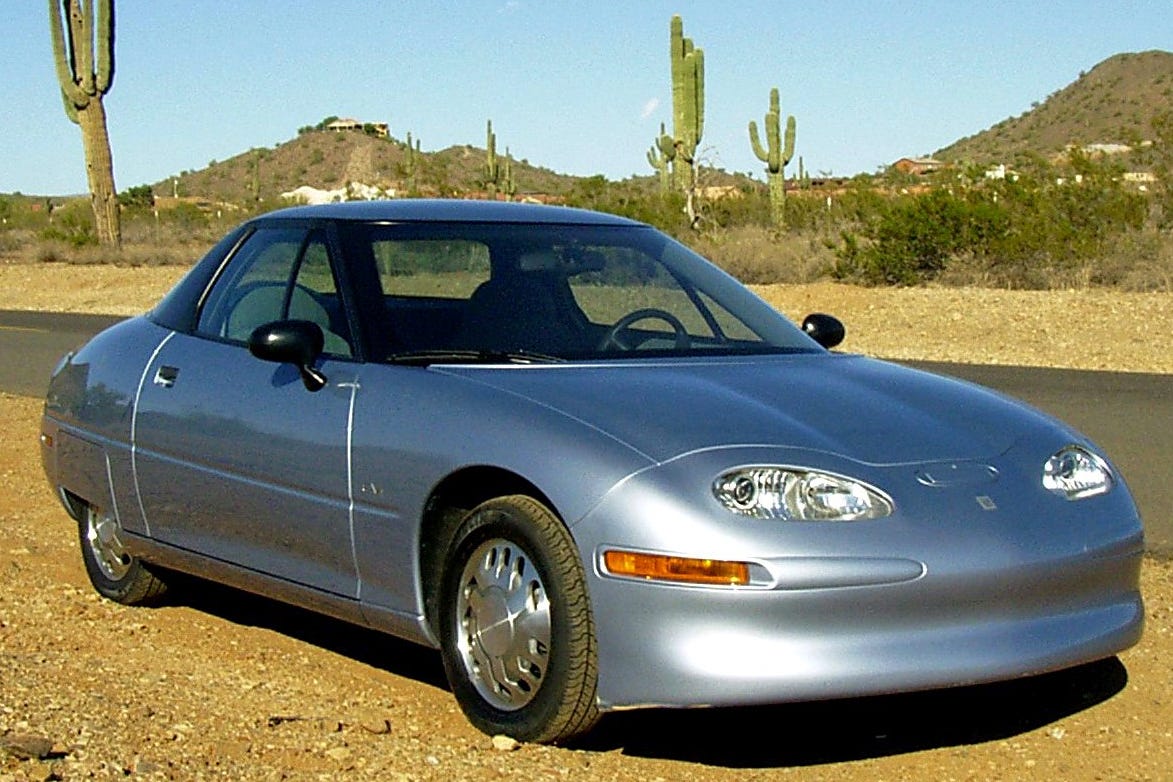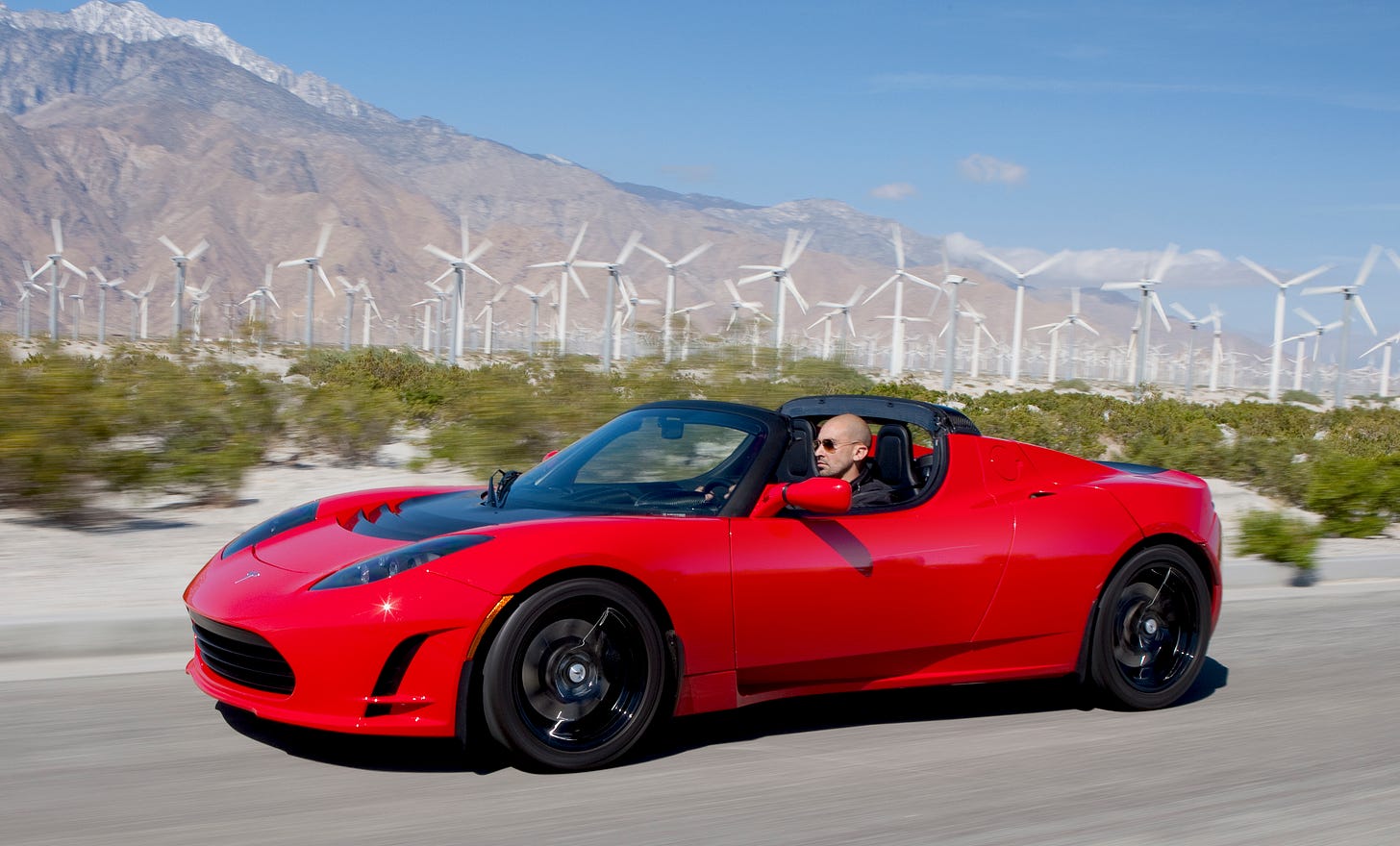In late 2023, there was a conversation in a smoke-filled gentleman’s club in London which probably went something like this:
[Michael Kelly]: I’d like to write an op-ed about electric vehicles. I don’t like these new fandangles.
[Editor of The Telegraph]: Excellent. That resonates with our core conservative audience. What’s your angle?
[MK]: They’re bad.
[Ed]: Sure. Sure. But, we need a take. Something catchy.
[MK]: Something about China.
[Ed]: Of course. But I still think we’ll need something more.
[MK]: How about, EVs are like NFTs for woke Hollywood actors?
[Ed]: Michael, I love the whole thing. But our readership consists of Tories over the age of 60 who still write to us asking what the e in email stands for. The NFT thing is not going to fly.
[MK]: Oh! Fly. How about “EVs will go the way of Concorde”?
[Ed]: Excellent! Now that’s a more relatable topic for our readership. Self-indulgent valorising of a former British industry while simultaneously decrying the very government which propped it up. Plus a few of our readers were regulars on the Paris route. When can you get me a draft?
And voilà, an op-ed was published in The Telegraph arguing that battery electric vehicles are doomed to the same fate as Concorde.
This is a stupefyingly dumb take and I’ll take some joy in explaining why.
What was Concorde?
In the 1950s, riding on the wave of government-driven science and a certain level of techno-optimism, and on the back of the technological development of military aircraft capable of supersonic speeds; the idea of commercial supersonic travel looked appealing.
Commercial supersonic travel was developed via several projects funded by four different governments — the Concorde project between the British and French, the Russian Tupolev-144, and the American Boeing 2707 and Lockheed L-2000 (of which the Boeing was progressed further before being canned by Congress in 1971).
When the Concorde project was first publicly announced in 1963 it’s primary competitor was the one credited with beginning the jet age – the narrow body Boeing 707 powered by turbojet engines.1 The first production 707-120 could seat 190 passengers (Concorde could seat between 90 and 120).
However, by the time of Concorde’s first commercial flight in 1976, it was competing against the wide body Boeing 747 powered by more efficient turbofan engines. The jumbo jet first flew in 1969 and could accommodate nearly four times the number of passengers. With greater fuel efficiency and more seats to sell, the playing field was never level.
The entire paradigm of air travel was rapidly evolving in the latter half of the twentieth century – supersonic travel explored one branch, while commercial subsonic travel rapidly evolved along a divergent branch, increasing efficiencies and driving down costs significantly.
Supersonic travel, and Concorde specifically was developed at the behest of governments who realised fairly early on that it wouldn’t be economic but decided that it was a worthwhile endeavour regardless. However it’s probably fair to say that even they didn’t expect the entire commercial airline industry to evolve so rapidly, in a direction which did not favour the economics of supersonic travel.
The end of Concorde, already getting long in the tooth, was accelerated by the fatal Air France Flight 4590 accident and the reduction in air travel following the 9/11 terrorist attacks. But the ultimate nail in the coffin was economics – the high cost and reduced payload of supersonic travel couldn’t compete with the economics of much bigger, slower, less thirsty planes.
How does the development of Concorde compare to that of battery electric vehicles?
I mean, other then that they’re made of metal, fuck all?
Development of battery electric vehicles has been a long and inconsistent road. The very first electric vehicles predate the 20th century. In the early 20th century, against primarily horses, trains and walking, the development of the internal combustion engine saw to the premature death of the electric vehicle. The low energy density of early battery chemistries couldn’t compete with energy density of dead dinosaur juice.
But development of the electric vehicle never truly died — researchers and tinkerers were always exploring, and the 1970s oil crisis drove a renewed interest in electric cars. But the technology was still largely immature and interest was muted at best.
The current development path of electric vehicles owes its lineage to resurgent environmental concerns in the 1990s (and some actual proper meaty emissions regulations) – General Motors demonstrated that the technology was mature enough to create a technically viable offering in the EV1, if not a commercial one.

But battery electric vehicle development was really kicked into high gear by a little Silicon Valley startup called Tesla Motors. Martin Eberhard (with co-founder Marc Tarpenning), a software engineer with a love of sport cars, concerns about global warming and energy security, and a background working for a technology dealing with lithium ion batteries aspired to build an all-electric roadster.
Some guy with a couple of spare bucks invested in the fledging startup and got heavily involved. The Tesla Roadster was released in 2008 to generally positive reviews. It was a sports car first, and an electric car second. And it demonstrated that the electric vehicle was really here.
Musk took increasing involvement in the company, eventually forcing Eberhard and Tarpenning out, and focused Tesla’s efforts on developing electric vehicles for the mass market. Each subsequent Tesla has been a step towards that,2 decreasing in cost and increasing in utility.
But most importantly, Tesla demonstrated to the car industry that not only was a battery electric vehicle both technically and commercially feasible, but it was a desirable purchase to many people. Tesla laid the groundwork for the development of a global race to develop electric vehicles.
What about hybrid vehicles?
A quick diversion here to note that there’s a couple of significant electric vehicles alumni missing from this history.
The Telegraph article specifically called out battery electric vehicles, and that’s what we’re interested in discussing here.
In the late 1990s Toyota and Honda released the Prius and Insight, respectively — hybrid electric vehicles which primarily use a conventional internal combustion engine, with a secondary electric engine. The electric engine is charged via the combustion engine or regenerative braking — there’s no ability to charge the electric engine’s small battery directly.
These early hybrids led to another development branch of electric vehicles — Plug-in Hybrid Electric Vehicles. As the name suggests, PHEVs can be plugged in to directly charge the electric engine battery, but can also operate via the combustion engine.
It remains to be seen how these two development branches of electric vehicles diverge, but in my opinion this would be the more apt comparison to Concorde, with PHEVs representing an initially obvious development branch pursued against a very rapidly evolving competitor.
Apples and cheese
When comparing the development histories of Concorde and BEVs, the analogy drawn in the op-ed doesn’t hold much water:
Concorde: Large scale government-driven research and development pursued supersonic travel against the rapidly developing jet age. By the time Concorde first flew, the landscape had already changed, and its only path forward to achieve any modicum of commercial returns was to appeal to those willing to pay a premium for convenience.
Concorde operated for 27 years, and there was no mechanism for economic or efficiency improvements – more routes weren’t opened, daily flights didn’t increase, new airlines didn’t purchase Concorde (only Air France and British Airways ever flew Concorde)3 and ticket prices didn’t come down. With some benefit of hindsight, supersonic travel was effectively doomed from the day it first took flight.
Battery electric vehicles: these vehicles have been a century plus in the making, with various private companies developing different offerings. Legislation, like the current net zero targets or the air quality bills of the 1990s, have helped set the scene for zero emissions vehicles, but no government is otherwise actively investing electric vehicles to anywhere near the same magnitude as supersonic travel.4
And this development is happening against a backdrop of mature and stagnated internal combustion engine (ICE) development – there are no significant developments being made in ICE technology and car manufacturers have not been pursuing any particularly ambitious R&D for a good while now. Battery electric vehicle development on the other hand, is positively explosive.5
The Professor Emeritus of Gronkery used his newspaper inches to argue that BEVs are like the early years of Concorde — billions of dollars piled into the development of a product purely for the wealthy.
But that just simply doesn’t reflect the state of play. Vehicles like the Tesla Roadster and their subsequent Model S retailed with six figure price tags, but in the subsequent decade EVs have progressed down the cost curve aggressively.
Last year (prior to the publication of the op-ed) BYD Auto, the Chinese EV manufacturer, both overtook Tesla as the world’s largest EV manufacturer and released the Seagull,6 a sub-$20K AUD BEV. Intended for the Chinese and Latin American markets, it’s evidence that low cost BEVs are already here.
Electric vehicles are here. They are no longer a fledgling technology and this is not a dead end development branch.
The future of BEVs?
Development and sales will continue, at pace.
This feels exceedingly obvious, but it’s the crux of the entire Telegraph op-ed. There
There has been some slowing in sales growth in the last year, including Tesla scaling back production in their Chinese factories. But even then, the sales numbers are still very much up and to the right.

Slower than anticipated, especially against some extremely aggressive sales, is hardly evidence that electric vehicles have reached their early peak.
One of the biggest indicators that BEVs are here to stay? The about-face from Toyota who after pissing a good chunk of money down the drain on hydrogen vehicles is finally doing some actual development work on BEVs.
The current refuelling paradigm will be upended.
I don’t think the general public has quite realised what electric vehicles will mean for the humble servo. A huge majority of urban drivers will be able to charge at home, using a good old standard 10A (2.4 kW @ 240 Volts) plug. The vast majority of charges will be simple top up charges, not the current paradigm of replacing the entire fuel tank in one hit. The fact that homes and businesses with solar could charge a car for free is even wilder.
But the wildest idea is that electricity, unlike the vast distribution network we’ve constructed for ferrying dead dinosaur juice around this country, is a utility that almost every home and business in the entire country has. There is nothing preventing an enterprising business from establishing EV chargers for customers or employees.
EVs will materially alter electricity networks.
EVs are literally batteries on wheels, shift electricity around the network wirelessly. Large numbers of EVs might charge at an employer’s premises and then drive back to the suburbs in the evening, running the house off-grid for the evening via vehicle-to-home (V2H).
Most of the current EVs for sale in Australia have batteries of at least 40 kWh, 3 times larger than a standard stationary home battery. For people with efficient and/or low energy homes, who don’t do a tonne of driving, they could effectively disconnect from the network for large periods of the year.
EVs moving energy around the system, will fundamentally change how we consume and pay for energy. Because although EVs will increase net energy consumption, where energy is consumed has been essential to the existing system system design. This is a threat and an opportunity for both retailers and distribution networks.
EV batteries will crush utility-scale batteries.
Much like rooftop PV has inexorably changed the economics of large scale solar, EV batteries will do the same to short duration utility-scale batteries. EV batteries, aggregated into a virtual powerplant capable of vehicle-to-grid (V2G) are already capable of providing all of the same services in the NEM (with the exception of regulation FCAS).
Vehicles for personal transport sit idle for 95% of the time, it makes perfect sense that these batteries could be better utilised, providing grid services and generating passive income.
Large delivery fleets of commercial trucks and buses, although seeing much higher utilisation, will sit behind larger infrastructure in industrial and commercial parts of the grid where they can potentially inject significant volumes of energy into the grid.
Why will EV fleets crush utility scale batteries? Because the commercial business case has already been written – a company is already switching to an EV fleet of trucks. Any additional revenue from utilising the battery in energy markets is just cream on top. Unlike utility scale batteries which need to go to investment committees for decisions and clearing investment hurdles, the purchasing decisions has already been made.
The rub
The premise of the argument, like most typical arguments against the energy transition, relies on seemingly measured and rational arguments based in twentieth century principles, usually delivered by self-important overly serious men in suits.
And like Scotty from Marketing’s assertion that EVs would “end the weekend”, trying to argue that BEVs are the unserious playthings of the wealthy is an attempt to appeal to the ‘everyman’ that these technological advances are not desirable or needed; that they’re being foisted upon us by governments.
But there’s no grand conspiracy to prop up an uneconomic industry here. In fact in a cost of living crisis the ‘everyman’ is increasingly moving towards more efficient technologies — 43% of EVs sold were to the outer metropolitan suburbs last year.
So no, there no similarities between Concorde and battery electric vehicles. Even crypto prices are back up, so might be time to meet with the editor again.
The first 707 powered by a turbofan entered in 1960, and later models gradually changed powertrains.
Except, perhaps that silly Cybertruck. And the new, delayed, second generation Roadster.
Singapore Airlines operated a Concorde route for a period… in partnership with British Airways.
With the probable exception of China, and the general exception that arguably no car industry is available without government support of some kind.
This is not an exploding lithium battery joke, but if you’re reading this article thinking ‘WhAt AbOuT aLl tHe LiThiUm FiRes?!’ you can have this one gratis, mmk.
I am genuinely obsessed with BYD’s model names. The Dolphin, Seal and Seagull are just so adorably offbeat.






Great post. Love your work. I thought I might just note, as perhaps a late footnote, that Tesla actually results more than marginally from the land down under. The biannual World Solar Challenge -- run through the red hot belly of the beast -- was apparently the key proving ground for what would become the first Tesla engineering team: https://electrek.co/2016/05/12/tesla-motors-stanford-solar-car-project-key/. Indeed, others argue that both Tesla and Google were borne from that experience, along with other companies whose total market capitalisation exceedds $2.5B: https://worldsolarchallenge.org/blogs/2023/10/21/why_solar_challenges_theyre_in_the_dna_of_tesla_google_for_starters
Great article Alex, as always amusing and accurate.